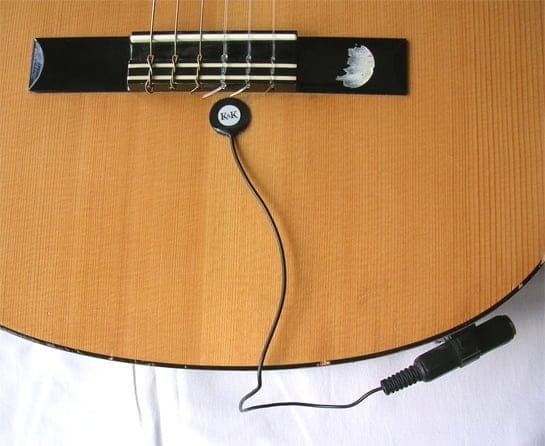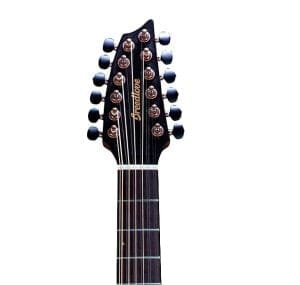Table of Contents
The sound of a classical guitar can be improved for live performance and recording with the help of an electronic accessory called a pickup. Although microphones are commonly used, pickups work better for me.
Switching the pickup on a classical guitar significantly affects the instrument’s sound. Including a pickup in your classical guitar’s amplification system is a good idea if you’re a serious musician. A pickup is a must if you want the cleanest possible guitar tracks. In this blog, I am going to explore guitar pickups in detail.
Don’t forget to check out other must-have guitar accessories lists.
Factors To Consider Before Pickup
You should know that putting pickups on a classical guitar is a permanent change. Once you make that change, it transforms the sound of your classical guitar, how you play it, and even how it looks.
Therefore, it’s essential to consider several factors before deciding to install pickups. Not everyone is ready to commit, so look into some things you should consider before installing pickups.
To begin, think about the various pickup options. Most classical guitar pickups are under the saddle, on the soundboard, or in the microphone. The most common type of pickup is the under-saddle variety because it requires less space and is less obtrusive.
Soundboard transducers are more sensitive and pick up more of the instrument’s natural resonance, but they can be more likely to cause feedback. Microphones pick up sound most accurately and dynamically, but they are also more prone to feedback, so they need to be placed strategically.
Second, you’ll need to do some serious carving if your classical guitar doesn’t already have a pickup system built in. Different pickups have different ways to set them up.
Undersaddle pickups can be put in without changing the guitar’s structure, but soundboard transducers and microphones often need more holes drilled in the guitar’s soundboard or body. Talk to a professional luthier beforehand about how it will affect the guitar’s structure and sound.
Pickups are expensive, especially if you want a high-quality one for a classical guitar. Aside from the pickups’ cost, other costs, such as materials and labor, may come with the installation. You should set a budget and determine whether the added expense is worth the potential benefits you might receive.
Too much distortion or electronic interference can ruin the delicate sound of a classical guitar. So unless you need to perform live onstage or use your classical guitar for recording purposes, pickups aren’t a necessity.
Under-saddle pickups can make a more synthetic sound, while soundboard transducers and microphones can pick up more of the guitar’s natural resonance.
Different Types of Classical Guitar Pickups
There are 3 basic types of pickups available for classical guitars. These pickups are different based on two things: sound and installation cost. Let’s talk about these different pickups.
1. Undersaddle Classical Guitar Pickup:
You’ll find under-saddle pickups almost everywhere, as they are one of the most common pickup systems for acoustic guitars, including classical guitars.
Piezoelectric pickups have a simple installation and building system. It consists of a strip of piezoelectric material embedded in a thin strip of material, such as plastic or composite. The strip is placed under the guitar’s saddle, which picks up the vibrations made by the strings. The preamp takes this vibration and enhances it.
You don’t need to worry about distortion or electronic feedback, as under-saddle pickups are highly resistant to electronic input and keep the sound of the strings distortion-free, even at super high volumes. They’re also known for capturing the sound of the strings accurately and evenly across all strings as they sit directly under the saddle. KNA NG-7S is a plug-and-play type piezo pickup that is quite famous.
However, you’ll find that under-saddle pickups tend to produce a slightly artificial tone that lacks the warmth and depth of a classical guitar’s natural, sweet acoustic sound. This is because the signal from the piezoelectric strips mostly picks up the strings’ vibration and not the guitar’s natural resonance. A huge sacrifice in terms of sound quality, in my opinion.
Recommended under-saddle pickups
• LR Baggs Element VTC Under-saddle Pickup
• Fishman Presys Pickup System
• LR Baggs Anthem Undersaddle Acoustic Guitar Pickup
2. Soundboard Transducers
Soundboard transducers are a type of pickup system that captures the sound of the classical guitar by sensing the vibrations of the soundboard. They use small sensors or transducers, usually made of magnetic materials, that are attached to the surface of the guitar’s soundboard, beneath the bridge, or on the top plate.
When the soundboard vibrates, it triggers the sensors, amplifying the sound. Unlike under-saddle pickups, soundboard transducers don’t rely on string vibrations alone to create an electrical signal. This allows them better to absorb the guitar’s organic tonal and resonant properties.
Pros: Soundboard transducers are popular among classical guitarists who value preserving the instrument’s acoustic characteristics. Also, they don’t get input as quickly as under-saddle pickups, so you can play loudly without any problems.
Cons: Soundboard transducers are more challenging to install than under-saddle pickups because they require drilling tiny holes in the guitar’s soundboard. Plus, you’ll need to spend more than you would for an under-saddle pickup. You’ll need to maintain them properly, regularly clean the transducers, and reposition the guitar’s soundboard or bridge if it changes over time.
Recommended Soundboard Transducers
• Fishman SBT-C Soundboard Transducer
• Takamine TP0894 Soundboard Transducer
• K&K PowerMix Pure Mini
3. Microphone-Based Classical Guitar Pickup
A microphone-based pickup system uses a microphone to capture the guitar’s sound, which is then amplified and processed using preamps, equalizers, and amplifiers.
You can use microphone-based pickup systems in several configurations. This can be done with one microphone near the soundhole, two microphones near the guitar’s upper and lower bouts, or a mix of internal and external microphones. The microphones can be either dynamic or condenser types. Condenser mics are more common.

Pros: One benefit of a microphone-based pickup system is that it will enable you to explore the full range of the guitar’s sound, including the natural resonance and harmonics that are hard to get with other pickups. You also get more versatility with this type of pickup.
Cons: Systems with microphones have the problem that they pick up background noise and feedback because they are sensitive to vibrations and sounds. Microphone-based pickups are less reliable during live performances, particularly in noisy or crowded venues.
Also, they are hard to set up and must be placed and positioned carefully to achieve the perfect sound. Since the mic is on the outside, even a little movement can cause tremendous issues with your guitar’s sound.
Recommended Microphone-Based Pickup
• K&K Meridian External Condenser Microphone
• Beyerdynamic TG i51 Dynamic Microphone
• DPA 4099 CORE Instrument Microphone
How do you add a pickup to a classical guitar?
Adding a pickup to a classical guitar involves a few steps to ensure the process is done correctly. Here’s a general guide.
Choose the Pickup Type: Different pickups are available for classical guitars. The most common options include under-saddle pickups, soundboard transducers, and internal microphones. Each has its unique characteristics, so choose the one that best suits your needs.
Gather the Necessary Tools and Materials:
Endpin jack or output socket
Soldering iron and solder (if required)
Screwdriver and other essential tools
Adhesive or putty (if needed for installation)
Remove the Strings: To work on your guitar comfortably, remove all the strings.
Access the Guitar’s Interior: Classical guitars typically have a removable saddle or a separate bridge that can be temporarily removed to access the interior. Some may have a soundhole cover that can be removed.
Install the Pickup: You’ll install the pickup in the right area depending on the type. Under-saddle pickups are installed beneath the saddle, soundboard transducers are attached to the soundboard, and internal microphones are installed within the guitar body.
Check out the evaluation of guitar body style here.
Secure the Wiring: Route the pickup’s wiring neatly through the guitar’s interior to avoid interference with the strings or other components.
Install the Endpin Jack: If your pickup system requires an endpin jack, carefully drill a hole at the base of the guitar, secure the jack in place, and connect it to the pickup wiring.
Test the Pickup: Before restringing the guitar, test the pickup to ensure it’s functioning correctly and producing the desired sound.
Reassemble the Guitar: Reinstall the bridge or saddle, close up the guitar’s interior, and restart it with your preferred set of strings.
Fine-Tune and Adjust: After restringing, you may need to adjust the pickup’s position or fine-tune the sound using any onboard controls, if available.
Suppose you’re uncomfortable performing these steps yourself. In that case, it’s advisable to seek professional assistance from a luthier or guitar technician to ensure the pickup is installed correctly and doesn’t damage your classical guitar.
Pickup vs Mic: Which one is Better?
The choice between a pickup and a microphone depends on your needs. Pickups are great for live gigs with less feedback and consistent sound. They’re practical. Microphones offer the most natural sound and capture room ambiance, making them perfect for recording.
If you are looking for a more direct and focused sound and are not concerned about feedback, then a pickup may be a good choice. If you are looking for a more natural and realistic sound, and you are willing to take the time to set up and use a mic properly, then a mic may be a better choice for you.
It’s a matter of what you prioritize. Some guitarists even use both to strike a balance.
So, there’s no one-size-fits-all answer; it’s about what works best for your music and performance style. Ultimately, the best way to decide which is better for you is to try both and see which one you prefer.
Will a piezo pickup work with nylon strings?
A piezo pickup can work with nylon strings on a classical guitar. Piezo pickups are versatile and can be used with various strings, including steel and nylon. However, you need to remember that the tonal characteristics of nylon strings differ from steel strings, and the pickup may capture those nuances differently.
Proper installation and adjustment are crucial to get the best results with nylon strings. Some pickups are designed explicitly for use with nylon-stringed instruments, and they may offer a more balanced and accurate representation of the classical guitar’s sound.
FAQs of Classical Guitar Pickups
You can’t record sound with pickups. But technically, yes, you can use guitar pickups as a microphone. They are not designed for this purpose, and the results will not be optimal. Guitar pickups are designed to pick up the vibrations of metal strings, not the sound waves of your voice. As a result, your voice will sound muffled and unclear when you speak into a guitar pickup.
Yes, a piezo pickup will work with nylon strings. Piezo pickups work by converting the vibrations of the strings into an electrical signal, so they are compatible with all types of strings, including nylon strings.
Piezo pickups are a popular choice for nylon string guitars because they produce a natural and transparent sound. They are also relatively easy to install and maintain.
No, you cannot use a magnetic pickup with a nylon-string acoustic guitar. Magnetic pickups work by detecting the magnetic field created by vibrating metal strings. Nylon strings are non-magnetic, so they will not create a magnetic field that can be detected by a magnetic pickup.
If you want to use a pickup with your nylon-string acoustic guitar, you will need to use a piezo pickup or a soundhole pickup. Both of these types of pickups are compatible with nylon strings and will produce a natural and transparent sound.
- Budget Classical Guitars Under $700 - February 15, 2025
- How To Set Up A 12-String Guitar Perfectly - September 8, 2023
- Vibrato Techniques: A Comprehensive Guide - September 6, 2023









